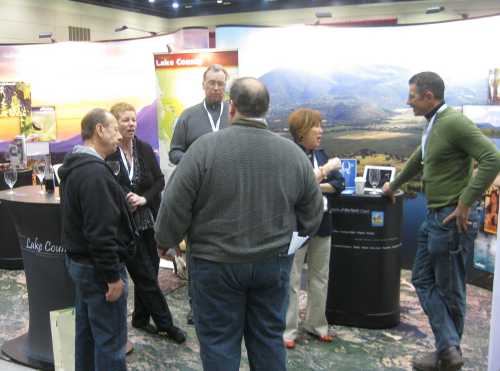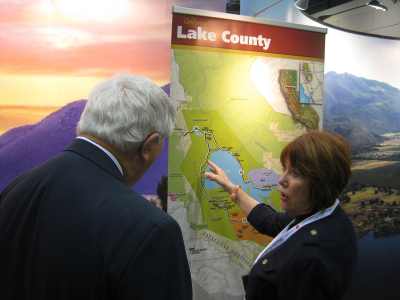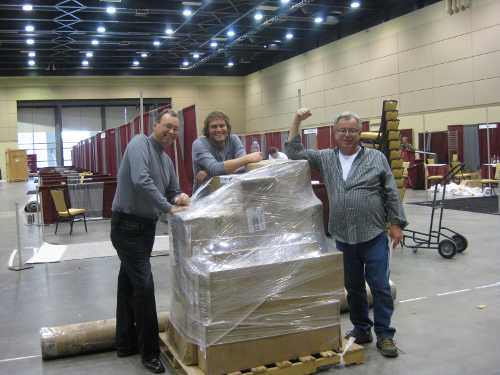- Lake County News Reports
- Posted On
Lake County showcased at wine industry shows

KELSEYVILLE, Calif. – Lake County’s participation at several national wine trade shows proved to be a “resounding success,” say representatives of the county’s administration and the Lake County Winegrape Commission.
A California Department of Food and Agriculture (CDFA) Specialty Crop Grant made it possible for the Commission to attend selected shows this year.
In January, a contingent of Lake County wine industry representatives traveled to the Unified Wine & Grape Symposium in Sacramento.
Participation in two shows in February took the delegates to the Midwest Grape and Wine Conference and Trade Show – billed as the third largest wine industry trade show in the United States – in St. Charles, Missouri, and to the Texas Wine and Grape Growers Association’s Annual Conference and Trade Show in San Marcos, Texas.
During the month of March, individuals worked the Commission’s booth at the Eastern Winery Exposition in Lancaster, Penn., and the Wineries Unlimited Trade Show and Conference in Richmond, Va.
Sharing information about Lake County’s wine industry and the county in general, commission President Shannon Gunier and commission board members were joined by county representatives and commission committee members at the various trade shows.
The Lake County contingent obtained information about potential winegrape buyers and businesses interested in the area. Gunier said leads are available to qualified Lake County growers by calling the Commission office, 707-995-3421.
“We poured wine and talked to interested parties about Lake County and the grapes we grow,” said Bill Brunetti, chair of the commission’s Industry Relations Committee.
Brunetti and his wife Patti attended the Pennsylvania and Virginia shows in March.
“In general, (we) tried to sell our county and our grapes,” Bill Brunetti said. “The county’s participation was well received. I think that the new booth pretty much outdid any other at the show. The wines spoke for themselves, and the presence of County personnel talking about the desire of Lake County to attract business was a home run.”
County Administrative Analyst Alan Flora echoed Brunetti’s sentiments about the reception of the County’s presence at the expositions.

“The interest generated in Lake County as a destination, a producer of fine wines, and as a place to do business exceeded all of my expectations,” said Flora. “The breadth of questions and comments were phenomenal. Few people were able to pass our booth by. Our booth design focused on a dramatic presentation of the scenic beauty of our County, the substantial and impressive development of our most established wineries, education about what makes our growing region so unique and full of potential, and the bold, complex, and delightful wines we produce.”
Budget constraints had forced the commission to cancel participation in out-of-state industry trade shows that had proven to be instrumental in showcasing Lake County wines in past years, according to Gunier.
Receipt of the CDFA Specialty Crop grant, dubbed by the commission as the “Lake County Rising Campaign” grant, allowed the winegrape growers organization to team with the county to continue marketing work at industry shows.
The grant was awarded to increase the effectiveness of the preexisting campaign, Gunier said.
“It was money very well spent,” Brunetti said about use of the grant funds. “There was certainly no downside to the commission's involvement; and even though most of our grape sales are closer to home, we do export to the East Coast. We also have a responsibility to our growers to promote the region, and that certainly was accomplished.”
Brunetti said he spoke with two people who indicated interest in opening wineries in Lake County. Additionally, one manufacturer of wine glasses made plans to visit the area to explore the idea of opening a facility in the county.
Flora, who attended shows in Sacramento, Texas, Pennsylvania and Virginia, said the official county presence “created quite an impression.”

“The commission asked me to be involved in an effort to expand the impact of the shows from the traditional marketing of winegrapes, juice, and bulk wine, to include promotion of Lake County as a recreation destination as well as an opportunity for development of vineyards, wineries, and/or wine related industries,” Flora explained.
“The (county’s) new ‘Growing the Wine Industry’ brochure and Development Incentive Program, which was put together by the County Economic Development Program, strongly emphasize our commitment to both the wine industry and growing our local economy,” Flora said. “Some folks (at the trade shows) even took extra copies of our information to present to their elected officials and say, ‘Look at what Lake County has done; we need to do this here.’ I think that speaks volumes to the commitment and determination our county has to grow a more vibrant economy in this place we love so much.”
The success of the shows will be measured by the demand for winegrapes from Lake County, Flora said.
“Many tons were sold as a result of the trade show exposure,” said Flora. “One winery owner demanded access to Lake County grapes after one taste of our Sauvignon Blanc. In another example, a winemaker sampled a local Syrah and exclaimed that it was the best he had ever tasted. Similar stories are endless, but the impact was noticeable and the exposure valuable.”
The impact on the area’s tourism may take longer to realize, Flora added. “However, I am confident that there will be an increase in visitors to Lake County as a result of the trade show exposure. There was a really significant interest in development opportunities and investment from a variety of parties.”
For more information about the Lake County Winegrape Commission’s marketing efforts and special events, visit the Commission’s website at www.lakecountywinegrape.org .


 How to resolve AdBlock issue?
How to resolve AdBlock issue? 






